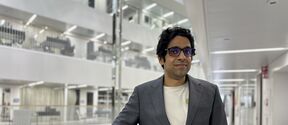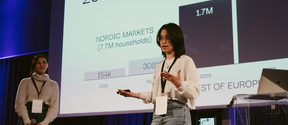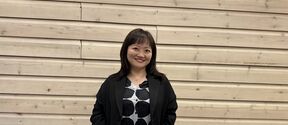The search for food safety

“Let’s start with the cow video! How many had milk today at breakfast,” asks design student Hilda Ruijs, who is taking part in Aalto University’s IDBM (International Design Business Management) programme.
The next morning, a team of students from Aalto and the University of Nairobi intends to ask 120 food security professionals the same question at Nairobi Innovation Week. The Slush-inspired event is being arranged for the fourth time now, and it will be attended by a broad group representing Finnish businesses, organisations and university actors. Just this dress rehearsal to go, and then Ruijs and Nairobian engineering student Duncan Mageto will be prepared to hear what final feedback the client, the Natural Resource Institute Finland LUKE, has to give. They need to fit the best bits about working together for three weeks into a 15-minute presentation.
The sitting room wall is dotted by seventeen A3 sheets filled with colourful Post-it notes. The team has studied each link of the food value chain, and the field work component took them to meet with small farmers, milk producers, feedstuff suppliers, street food vendors and researchers.
“We met with all these people and tried to put ourselves in their shoes,” Hilda Ruijs tells a practice audience consisting of her teammates.
Tracking a hidden toxin
LUKE has given the students free hands to utilise the results of the FoodAfrica research project: the team’s goal is to identify fresh ways to tackle aflatoxins, carcinogenic compounds that can lie hidden in staple commodities. Aflatoxins are caused by certain moulds, and they can occur in, for example, maize that has been stored in damp conditions. Using spoiled maize as fodder for dairy cattle will lead to toxic milk.
“Aflatoxin cannot be removed from the milk – even processing will not change this. A large portion of the milk we here in Kenya consume contains these toxins. People are just unaware of this,” says social scientist Benjamin Atika from University of Nairobi’s team.
The team has ascertained that maize traders, who also store maize and influence its resale, are of key importance to finding a solution. Toxic maize sells well because of its low price.
“One packet of it is right there in our fridge,” Loi Tran, a student of entrepreneurship at Aalto, says and points to the kitchen.
Often, only bigger farms have the negotiating power and ability to test for aflatoxins. Smallholders are in a challenging situation because the tests are expensive, in addition to which their entire crop is at the mercy of an increasingly unstable climate. The rain is torrential right now – the rainy season is starting early, while there was barely any rain at all one year earlier.
“Farming is wholly dependent on rainfall and the people are dependent on farming. If you have sowed seeds to germinate and the rain comes at the wrong time, you have to start the whole thing over. There’s not many factors in this chain that farmers can influence,” says IDBM student Maaria Tiensivu.
Her service design background has helped Tiensivu to articulate even the more complex issues.
“This has been eye-opening for me. Everything I ever knew about plants – that they require sunlight and watering – got replaced. You never water plants, just let the rainy season handle it,” she laughs.
There have been plenty of fresh insights, as the ten-strong team includes people with backgrounds from many different scientific disciplines.
“This project has helped me understand they way in which others think, which will benefit me in working life as well. It has, in fact, been more like work than studying – in a good way,” Tiensivu notes.
Learning in a new way
The Aalto team has been engaged in background work for this project since November 2017, while the Nairobi students got involved through a new course this February.
“Field work in particular has been very different than in our other courses. Normally, we do our studying on campus and at lectures,” says Unelker Maoga, student of environmental science.
Computer science lecturer Peter Okech, who has provided supportfor the student team, shares a similar view: “The things we are familiar with in theory have been realised in practice.”
The University of Nairobi is one of three East African institutions of higher education that are developing problem-based learning. PBL East Africa is a joint three-year project of Aalto, Makerere University, University of Dar es Salaam and the University of Nairobi, which is being coordinated by Aalto Global Impact. The IDBM and Creative Sustainability Master’s degree programmes as well as the Sustainable Global Technologies and Digital Services for Sustainability courses are taking part. The students’ shared projects take place in spring.
“It’s amazing what the students have managed to achieve in such a short time. They have worked very independently. Working for a client as well as for the teachers has been a novelty to us,” Peter Okech says.
Although the Nairobi component will soon end, the closely welded team will continue working together from their respective home universities.
The makings of a solution
Finland’s ambassador to Kenya Tarja Fernández and Kenya’s Agriculture and Research Principal Secretary Hamadi Boga have delivered their opening addresses to the Improving Food Security Through Shared Value and Innovation seminar. Now it is time for the students to take the stage.
“We’ve dived into the value chain of food safety. We want to discuss our preliminary results with you: testing for aflatoxins, maize drying and storing methods, training and know-how, transparency and support for communities as well as politics and regulations,” Duncan Mageto and Hilda Ruijs begin their pitch.
Instead of simple solutions, problem-based learning provides a deeper understanding of what might make up the solution.
“There are countless right answers.”
aaltoglobalimpact.org/pbl-east-africa
This article is published in the Aalto University Magazine issue 22 (issuu.com), April 2018.
Read more news

Virtual Reality and AI summer course focuses on technology as a means for human-centric innovation
Gautam Vishwanath is the teacher for the new summer course Introduction to Virtual Reality and Artificial Intelligence this summer. In this interview, he lets us in on how these technologies will reshape how we experience history, empathise with distant conflicts, and influence persuasion.
Aalto University to host INNOVA Europe 2026 Grand Final in Espoo
Aalto University will host the INNOVA Europe 2026 Grand Final in Espoo, bringing together leading student-led startups from European universities.
Become a confident English speaker this summer
Aalto University Summer Schools offers a brand-new course for students who want to take their English to the next level in professional situations like pitching, presenting a project, leading a team, giving or receiving feedback or in multicultural settings.






